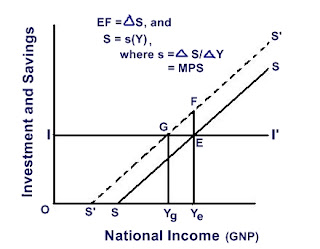 Thriftiness
ThriftinessThriftiness means an increased desire to save or a decreased desire to consume. In other words, it implies an upward shift of the savings function, or what comes to the same thing as a downward shift of the consumption function. b↓ + s↑ = 1, where b = Marginal Propensity to Consume, and s = Marginal Propensity to Save.
The classical economists argue that thriftiness is beneficial for the society. This is because more savings means more capital formation, and more output of consumption and capital goods.
This view was challenged by Mr. J. M. Keynes and he said that if the economy is in depression, the problem is one of raising the effective demand. Under this situation, an increase in thriftiness means a fall in demand and ultimately a fall in income through the multiplier.
Autonomous investment and Thriftiness

Autonomous investment is completely elastic, as it has no relationship with Gross National Product (GNP) or its rate of change. Level of autonomous investment depends upon rate of interest and marginal efficiency of capital.
SS is the original Savings function where OYe is the National Income. II' is the Investment Function. Aggregate Savings S = s(Y), where s = MPS or marginal Propensity to Save. E is the equilibrium point where savings = investment. When savings is equal to investment, national income is equal to national expenditure. Therefore, OYe is the equilibrium level of income.
If there is an increase in thriftiness or an increased desire to save, the savings function will move upwards to S'S'. Then EF measures the increase in savings (ΔS) at the same level of income. Income remains the same but savings increases, resulting into a reduction in consumption. Now the new Savings Function, S'S', cuts the Investment function II' at G. So G is the new equilibrium point and it corresponds to a lower equilibrium level of income, OYg. Therefore national income falls by ΔY, due to an increase in savings by ΔS.
So savings is damaging to the economy. Ultimately, it lowers the income.
Must also read: Induced Investment and Thriftiness

No comments:
Post a Comment
Want to say something? Say it!